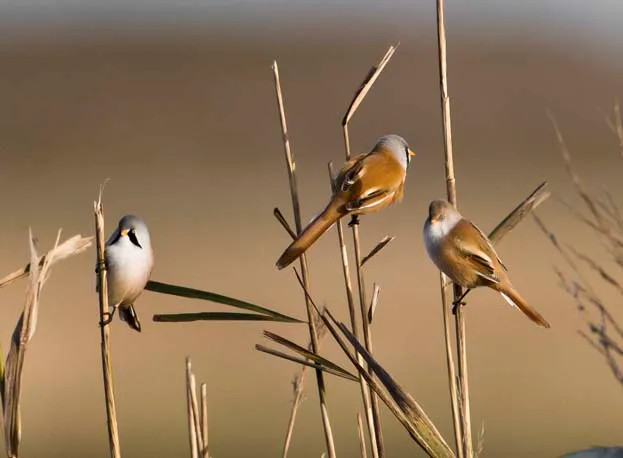1. Not a bearded tit
Despite its name, the bearded tit is neither bearded nor a tit! It actually has a moustachioed-look to its plumage and for a while it was considered a member of the parrotbill family, but now it is thought to be more closely related to larks.
2. Reedbed inhabitant
Bearded tits are the only British songbird to stay in reedbeds all year round. Originally they were limited by the availability of reedbeds in Britain, but thanks to newly created or expanded reedbeds, they are now more widespread and can be found in parts of eastern and southern England, Morecambe Bay in northwest England and around the Tay estuary in Scotland.
3. Occasional movements
Although bearded tits are not well known for migration, there is some movement in the autumn through local dispersal. On occasion, there is also an influx of continental birds from mainland Europe. They are more gregarious outside of the breeding season, and therefore tend to be easier to see.
4. Breeding behaviour
There are only around 630 breeding pairs of bearded tits found in Britain, most likely due to the fact that they are limited by habitat. They build their nests low down in the reeds, often on piles of dead reed stems. They will use specially designed nest boxes, which were created to bypass their susceptibility to flooding. They are prolific breeders that can have up to four broods a year, with four to eight eggs per brood!

© Allan Drewitt/BTO
5. Alterations
Bearded tits survive in the reedbeds all year round by changing their diet from insects during the spring and summer, to seeds in the autumn and winter. They cope with this by altering their gut morphology, and by eating large amounts of grit particles that help to grind down the tough seed fibres.
6. Vulnerability
Due to their range restriction, bearded tit populations can be vulnerable to particularly harsh winters, flooding and saltwater inundation into reedbeds. As a result local extinctions can occur. For example, in the cold winter of 1947 the East Anglian population decreased to just four or five pairs in Suffolk and a lone male in Norfolk. It is thought that the snow cover prevented them from accessing the seeds they needed to survive.
7. 'Moustachioed tits'
Bearded tits are sandy brown with long tails, yellow bills and eyes. The males have grey heads with a conspicuous black ‘moustache’ that flanks the throat. Females are duller and lack the moustache. They have a distinctive ‘ping’ call when they fly, which you will usually hear before you see them.
The British Trust of Ornithology (BTO) works in partnership with over 40,000 volunteer birdwatchers to chart the fortunes of UK birds.
Among the surveys that we coordinate is our popular Garden BirdWatch, the largest year-round survey of garden birds in the world.
For more information about Garden BirdWatch or to speak to the Garden Ecology Team please email gbw@bto.org
The BTO coordinates BirdTrack, a system that allows you to keep a record of the birds you have seen whilst contributing to our birds in Britain and Ireland and beyond. This is a partnership project between the BTO, the RSPB, Birdwatch Ireland, the Scottish Ornithologists’ Club and the Welsh Ornithological Society.
Find out more at more information at the BirdTrack website.

